If America is attacked, the strike probably won’t come from North Korea. And it will be even scarier than we imagine.
Photo: Getty Images/photo-illustration by Gluekit
06/12/2018 8:00 am
In his efforts to Make America Great Again, Donald Trump has succeeded in reviving at least one aspect of America’s past: the fear of nuclear war. Since taking office, the president has boasted about the size of his “Nuclear Button,” jettisoned the nuclear deal with Iran, and threatened to unleash “fire and fury like the world has never seen” on North Korea. His national-security adviser, John Bolton, openly advocates a first-strike policy against nuclear-armed enemies, and the Pentagon, after decades of careful disarmament, wants to spend $1.2 trillion to upgrade its nuclear arsenal. If you’ve felt a new shiver of nuclear fear over the past year, you’re not alone: The Bulletin of the Atomic Scientists has moved its “Doomsday Clock” to within two minutes of midnight — closer than it has been since the height of the Cold War. In January, when a state employee in Hawaii mistakenly triggered an emergency alert, warning that a ballistic missile was inbound, many islanders raced to take shelter and unite with their loved ones, believing they were only minutes away from utter devastation.
What made the false alarm all the more frightening is just how plausible the prospect of a nuclear strike has become. The U.S. and Russia, both of which maintain massive nuclear arsenals, are increasingly at odds. Iran has announced plans to ramp up its production of enriched uranium. North Korea may already have nuclear missiles capable of striking anywhere in the U.S., and there is no way to know whether Trump’s negotiations with Kim Jong-un will wind up increasing or decreasing the prospect of nuclear war. But the current state of dread, while entirely understandable, has overshadowed two crucial realities about the threat of a nuclear calamity. First, a nuclear attack on the United States could well come not from the skies but from the streets. Experts warn that it would be relatively easy for terrorists to build an “improvised nuclear bomb” and smuggle it into America. Building a ten-kiloton bomb nearly as destructive as the one dropped on Hiroshima would require little more than some technical expertise and 46 kilograms of highly enriched uranium — a quantity about the size of a bowling ball.
The second reality we have failed to understand is what a nuclear detonation and its aftermath would actually look like. In our imaginations, fueled by apocalyptic fictions like The Road and The Day After, the scale and speed of nuclear annihilation seem too vast and horrific to contemplate. If nuclear war is considered “unthinkable,” that is in no small part because of our refusal to think about it with any clarity or specificity. In the long run, the best deterrent to nuclear war may be to understand what a single nuclear bomb is capable of doing to, say, a city like New York — and to accept that the reality would be even worse than our fears.
What Happens When a Nuclear Bomb Hits
The Bomb
There are currently at least 2,000 tons of weapons-grade nuclear material stored in some 40 countries — enough to make more than 40,000 bombs approximately the size of the one that devastated Hiroshima. Stealing the material would be challenging but far from impossible. Russia stockpiles numerous bombs built before the use of electronic locks that disable the weapons in the event of tampering. Universities that handle uranium often have lax security. And insiders at military compounds sometimes steal radioactive material and sell it on the black market. Since 1993, there have been 762 known instances in which radioactive materials were lost or stolen, and more than 2,000 cases of trafficking and other criminal activities.
Once terrorists obtained the uranium, they would need only a small team of sympathetic engineers and physicists to build what is known as a gun-type nuclear bomb, like the one dropped on Hiroshima. A gun-type nuke uses traditional explosives to fire a slug of uranium through a tube directly into another chunk of uranium, fracturing huge numbers of atoms and unleashing a massive amount of energy. Compared to modern nuclear missiles, which are far more powerful and complex, constructing a crude gun-type nuke is fairly straightforward. In 2002, when Joe Biden was chairman of the Senate Foreign Relations Committee, he asked several nuclear laboratories whether a terrorist group could construct an off-the-shelf nuclear weapon. Several months later, they gave their answer: Without resorting to any illegal activities or drawing on classified information, and using only commercially available parts, they had built a nuclear bomb that was “bigger than a breadbox but smaller than a dump truck.” To underscore the danger, Biden had them bring the device to the Senate.
The last step in the process — smuggling the weapon into the United States — would be even easier. A ten-kiloton bomb, which would release as much energy as 10,000 tons of TNT, would be only seven feet long and weigh about 1,000 pounds. It would be simple to transport such a device to America aboard a container ship, just another unseen object in a giant metal box among millions of other metal boxes floating on the ocean. Even a moderate amount of shielding would be enough to hide its radioactive signature from most detectors at shipping hubs. Given all the naturally radioactive items that frequently trigger false alarms — bananas, ceramics, Brazil nuts, pet deodorizers — a terrorist group could even bury the bomb in bags of Fresh Step or Tidy Cats to fool inspectors if a security sensor was tripped. In 1946, a senator asked J. Robert Oppenheimer, the physicist who played a key role in the Manhattan Project, what instrument he would use to detect a nuclear bomb smuggled into the United States. Oppenheimer’s answer: “A screwdriver.” Amazingly, our detection systems have still not caught up to this threat: One would essentially have to open and visually inspect every single crate and container arriving on America’s shores. Once the container ship reached a port like Newark, terrorists would have no trouble loading the concealed bomb into the back of an unassuming white van and driving it through the Lincoln Tunnel directly into Times Square.
The Blast
One of the greatest misconceptions about nuclear bombs is that they annihilate everything in sight, leaving nothing but a barren flatland devoid of shape and life. In truth, the physical destruction inflicted by a nuclear explosion resembles that of a combined hurricane and firestorm of unprecedented proportion. Consider one example: A ten-kiloton nuclear bomb detonated on the ground in Times Square would explode with a white flash brighter than the sun. It would be seen for hundreds of miles, briefly blinding people as far away as Queens and Newark. In the same moment, a wave of searing heat would radiate outward from the explosion, followed by a massive fireball, the core of which would reach tens of millions of degrees, as hot as the center of the sun.
When such a bomb explodes, everyone within 100 feet of ground zero is instantaneously reduced to a spray of atoms. There are photos from Hiroshima and Nagasaki showing eerie silhouettes of people cast against a flat surface, such as a wall or floor. These are not, as is sometimes claimed, the remains of vaporized individuals, but rather a kind of morbid nuclear photograph. The heat of the nuclear explosion bleaches or darkens the background surface, except for the spot blocked by the person, leaving a corresponding outline. In some cases the heat released by the explosion will also burn the patterns of clothing onto people’s skin.
One of the greatest misconceptions about nuclear bombs is that they annihilate everything in sight, leaving nothing but a barren flatland.
Near the center of the blast, the suffering and devastation most closely conform to the fictional apocalypse of our imaginations. This is what it would look like within a half-mile of Times Square: Few buildings would remain standing. Mountains of rubble would soar as high as 30 feet. As fires raged, smoke and ash would loft into the air. The New York Public Library’s stone guardians would be reduced to pebble and dust. Rockefeller Center would be an unrecognizable snarl of steel and concrete, its titanic statue of Prometheus — eight tons of bronze and plaster clad in gold — completely incinerated.
Within a half-mile radius of the blast, there would be few survivors. Those closest to the atomic bombings on Hiroshima and Nagasaki have described the horrors they witnessed: People with ripped sheets of skin hanging from their bodies; people whose brains were visible through their shattered skulls; people with holes for eyes. Sakue Shimohira watched her mother’s charred body crumble into ash as she tried to wake her. Shigeko Sasamori’s father cut off the blackened husk of skin all over her face, revealing pools of pus beneath.
As the fireball travels outward from the blast, people, buildings, and trees within a one-mile radius would be severely burned or charred. Metal, fabric, plastic, and clay would ignite, melt, or blister. The intense heat would set gas lines, fuel tanks, and power lines on fire, and an electromagnetic pulse created by the explosion would knock out most computers, cell phones, and communication towers within several miles.
Traveling much farther than the fireball, a colossal pressure wave would hurtle forth faster than the speed of sound, generating winds up to 500 miles per hour. The shock wave would demolish the flimsiest buildings and strip the walls and roofs off stronger structures, leaving only their naked and warped scaffolding. It would snap utility poles like toothpicks and rip through trees, fling people through the air, and turn brick, glass, wood, and metal into deadly projectiles. A blast in Times Square, combined with the fireball, would carve a crater 50 feet deep at the center of the explosion. The shock wave would reach a diameter of nearly 3.2 miles, shattering windows as far as Gramercy Park and the American Museum of Natural History.
All this would happen within a few seconds.
From Van to Tsunami
Five different nukes, and what they would do if unleashed on Times Square.
10 Kilotons
Puny by current standards, a ten-kiloton terrorist bomb detonated on the ground in Times Square would deliver a blast nearly as destructive as the nukes dropped on Hiroshima and Nagasaki. Estimated injured and killed in blast: 550,000.
250 Kilotons
This is the nuke that North Korea is believed to have tested last year. Though smaller than many warheads, a 250-kiloton bomb, detonated in the air, would create a larger shock wave and fireball than a ground explosion. Estimated injured and killed in blast: 2.9 million.
800 Kilotons
Russia’s ballistic missiles often carry multiple warheads that disperse to hit multiple targets. A single warhead would destroy most buildings in Manhattan and expose people from Park Slope to Secaucus to thermal radiation. Estimated injured and killed in blast: 4.6 million.
5 Megatons
China’s DF-5missile carries a “city buster” nuke that could incinerate midtown Manhattan, destroy homes across northern New Jersey and Long Island, and subject beachgoers in the Rockaways to third-degree burns. Estimated injured and killed in blast: 7.9 million.
100 Megatons
Designed by the Soviet Union, the “Tsar Bomba” could be detonated via a nuclear-powered underwater vehicle called the Poseidon, triggering a 1,600-foot-high radioactive tsunami that would devastate the coastline. Estimated injured and killed in blast: 14.7 million.
The Fallout
The Path of the Fallout: Within two hours of an attack on Times Square, a plume of radioactive fallout would unfurl 60 miles beyond the city. Depending on the weather, the plume could reach upstate New York, Trenton, or midway across Long Island. Maximum Exposure (orange):Extends for 20 miles. Some survivors fall ill; risk of cancer jumps by 10 percent. The Hot Zone (yellow):Reaches 60 miles. Lingers for weeks, contaminating food and water supplies. Photo: Remie Geoffroi
The moment a nuclear bomb detonates, several forms of nuclear radiation instantly permeate the environment. As this pulse of radiation surges through the bodies of everyone who is outside, or in weakly insulated buildings, it wreaks biological havoc at the molecular level. By altering the structure of key cellular machinery and injuring DNA, the radiation impairs the ability of cells to replicate and repair themselves. A ground detonation of a ten-kiloton bomb in Times Square would subject everyone between Murray Hill and Hell’s Kitchen, and from 32nd Street to the bottom of Central Park, to a potentially lethal dose of radiation.
Within minutes to hours, most people exposed in these areas would begin to show signs of acute radiation syndrome: nausea, headache, dizziness, and vomiting. After several days to two weeks, new symptoms would emerge: diarrhea, hair loss, fever, seizures, and bleeding in the mouth and under the skin, which sometimes creates purple blotches on the body. In the most severe cases, people would become emaciated, delirious, and incapacitated. Most people with radiation sickness will die for one of two reasons: because they no longer have enough immune cells to fight off microbial infections, or because their digestive system is too damaged to function properly.
The radiation released instantaneously by an explosion is only a prelude to a much more insidious and long-lived threat. Immediately after the blast, a huge fireball would rise swiftly through the air and begin to condense into a mushroom cloud, tinted red at first, then white. A strong updraft and inflowing winds would suck soil and debris, already bonded with radioactive particles released by the explosion, into the cloud. Within 15 minutes, a portion of this radioactive dust — mostly grains the size of salt or sand — would begin to fall directly on the city. Within a day, some survivors exposed to the dust would begin to experience itching and burning sensations; within two to three weeks, lesions would begin to appear. Fallout that is inhaled or swallowed, or that enters the body through a wound, would be even more dangerous: It exposes internal organs to a continuous source of nuclear radiation, damaging tissue in the same way as the initial pulse of radiation from the explosion itself.
The Day After
What would happen if a ten-kiloton terrorist bomb were detonated in Times Square.
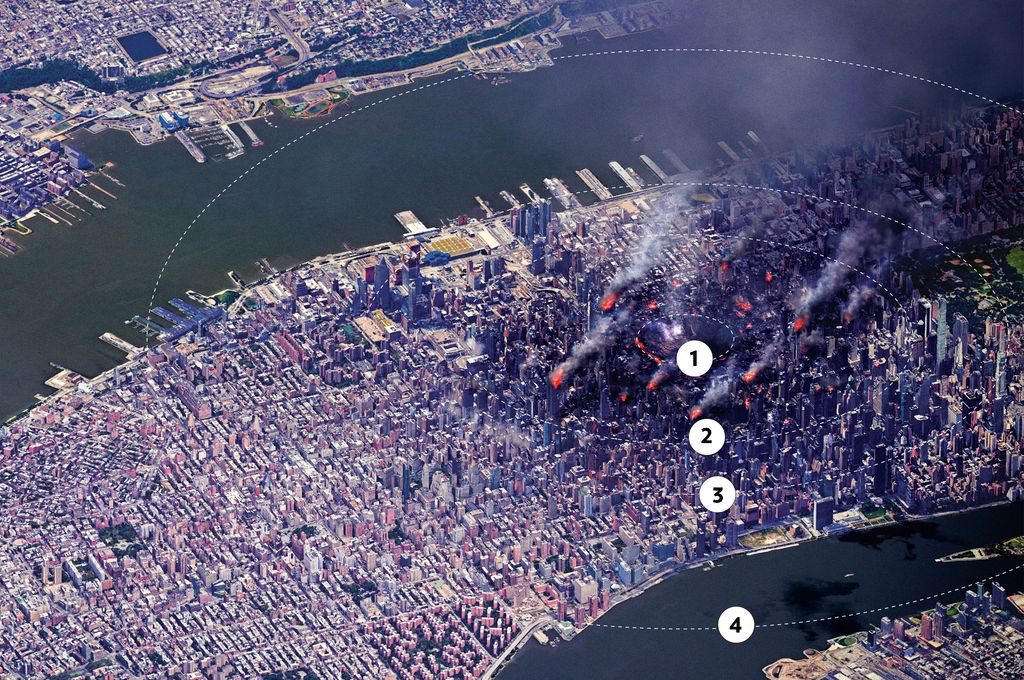
The moment a nuclear bomb detonates, several forms of nuclear radiation instantly permeate the environment. As this pulse of radiation surges through the bodies of everyone who is outside, or in weakly insulated buildings, it wreaks biological havoc at the molecular level. By altering the structure of key cellular machinery and injuring DNA, the radiation impairs the ability of cells to replicate and repair themselves. A ground detonation of a ten-kiloton bomb in Times Square would subject everyone between Murray Hill and Hell’s Kitchen, and from 32nd Street to the bottom of Central Park, to a potentially lethal dose of radiation.
Within minutes to hours, most people exposed in these areas would begin to show signs of acute radiation syndrome: nausea, headache, dizziness, and vomiting. After several days to two weeks, new symptoms would emerge: diarrhea, hair loss, fever, seizures, and bleeding in the mouth and under the skin, which sometimes creates purple blotches on the body. In the most severe cases, people would become emaciated, delirious, and incapacitated. Most people with radiation sickness will die for one of two reasons: because they no longer have enough immune cells to fight off microbial infections, or because their digestive system is too damaged to function properly.
The radiation released instantaneously by an explosion is only a prelude to a much more insidious and long-lived threat. Immediately after the blast, a huge fireball would rise swiftly through the air and begin to condense into a mushroom cloud, tinted red at first, then white. A strong updraft and inflowing winds would suck soil and debris, already bonded with radioactive particles released by the explosion, into the cloud. Within 15 minutes, a portion of this radioactive dust — mostly grains the size of salt or sand — would begin to fall directly on the city. Within a day, some survivors exposed to the dust would begin to experience itching and burning sensations; within two to three weeks, lesions would begin to appear. Fallout that is inhaled or swallowed, or that enters the body through a wound, would be even more dangerous: It exposes internal organs to a continuous source of nuclear radiation, damaging tissue in the same way as the initial pulse of radiation from the explosion itself.
The Day After
What would happen if a ten-kiloton terrorist bomb were detonated in Times Square.
Photo-Illustration: Justin Metz
1. The Fireball
5 blocks
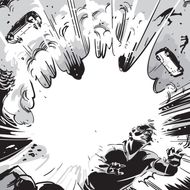
1. The Fireball
5 blocks
Illustration: Remie Geoffroi
Following a flash brighter than the sun, a massive fireball would blast a crater 50 feet deep and cremate almost everything — and everyone — between Sixth and Eighth Avenues. Those taking the subway would be killed when the entire station collapses.
2. The Shock Wave
25 blocks
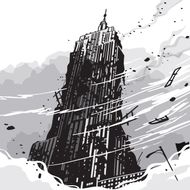
Following a flash brighter than the sun, a massive fireball would blast a crater 50 feet deep and cremate almost everything — and everyone — between Sixth and Eighth Avenues. Those taking the subway would be killed when the entire station collapses.
2. The Shock Wave
25 blocks
Illustration: Remie Geoffroi
Winds of up to 500 mph would raze buildings and turn cars and lampposts into deadly projectiles. Anyone standing near a window would be killed by a hurricane of glass shards. The Empire State Building would look like a charred tree trunk after a forest fire.
3. The Radiation
35 blocks
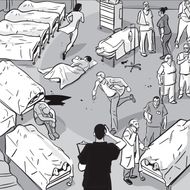
Winds of up to 500 mph would raze buildings and turn cars and lampposts into deadly projectiles. Anyone standing near a window would be killed by a hurricane of glass shards. The Empire State Building would look like a charred tree trunk after a forest fire.
3. The Radiation
35 blocks
Photo: Remie Geoffroi
Within weeks of the blast, up to 90 percent of the survivors within this range would die from the bomb’s initial burst of radiation. The remainder would suffer third-degree burns and scarring from thermal radiation, which can require amputation.
4. The Wind Storm
65 blocks
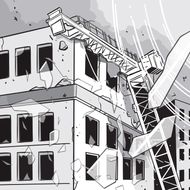
Within weeks of the blast, up to 90 percent of the survivors within this range would die from the bomb’s initial burst of radiation. The remainder would suffer third-degree burns and scarring from thermal radiation, which can require amputation.
4. The Wind Storm
65 blocks
Illustration: Remie Geoffroi
Winds of 40 mph would shatter windows facing the blast and send construction cranes careening into the streets below.
Casualties
Killed in the blast: 250,000
Injured in the blast: 300,000
Killed or Injured by the fallout: 500,000
The Survivors
Only people at ground zero would be instantly and painlessly vaporized by the blast. Many more — hundreds of thousands — would be horrifically injured and killed by the inordinate heat and staggering shock wave. They would be scorched to death, crushed by collapsing buildings, suffocated beneath rubble, and pierced with flying chunks of glass and metal. Many would be consumed by secondary fires. Farther out from the blast — only 1.5 miles away — the scene would resemble the aftermath of a strong storm: broken windows, stalled and crashed cars, litter and rubble, minor injuries. Neighborhoods in Queens, Brooklyn, Yonkers, and New Jersey that still had power would continue to function normally. In the immediate aftermath of the explosion, millions of residents would find their homes still habitable, their communities intact, their daily routines largely undisrupted.
A terrorist-built nuclear bomb detonated in Times Square would injure 300,000 people and kill 250,000 — 20 times more deaths than in any natural disaster or act of terrorism in America’s history. More than 500,000 would eventually be killed or injured by the radioactive fallout. But this is just the toll from a bomb that is puny compared to modern nuclear missiles. A larger nuke — a 300-kiloton warhead, say, of the type possessed by Russia and China — would kill at least 1.2 million and injure another 2 million. Overall, a nuclear missile detonated in the air over New York City would be more destructive and deadlier than a ground explosion, because it would generate a larger blast wave and fireball. By contrast, a nuclear bomb detonated on the ground loses some of its destructive power, because the energy is absorbed by the ground itself, but kicks up more dirt and debris, producing a much larger amount of radioactive fallout and causing a higher proportion of deaths from radiation sickness and cancer.
Once it became clear that Times Square had been hit by a nuclear bomb, many people outside ground zero would attempt to flee, not realizing that cars provide virtually no protection from fallout. The survivors who fared best would be those who heeded the government’s official advice in the event of a nuclear attack: Get inside, stay inside, stay tuned. Though the words sound incommensurate with the horror and devastation of a nuclear explosion, the smartest thing to do directly before or after a nuclear blast is to surround yourself with as much solid material as possible, to provide a physical barrier against the heat, pressure, and fallout released by the detonation. A clerk named Eizo Nomura was only 560 feet from ground zero in Hiroshima, yet he survived because he happened to be retrieving documents from the basement of a reinforced-concrete building.
The ideal shelter is a strong underground structure, such as a basement, tunnel, or parking garage. The very center of a large, sturdy building also provides some protection: the middle of the middle floor, or as close to it as possible. New York once had some 18,000 nuclear-fallout shelters stocked with food and medical supplies, but most were long ago converted into restaurants and bars. In 1975, the city went from shelter to shelter removing all the drugs from the first-aid kits to prevent them from being stolen by junkies.
After taking shelter, survivors who managed to find working radios, TVs, and cell phones would be advised to consume only food and water in sealed containers. Those exposed to fallout would be instructed to remove their clothes and wash or wipe down their skin, to get rid of radioactive particles. Although fallout is extremely dangerous at first, it decays rapidly. Within 24 to 72 hours of an explosion, it would be safe to reemerge. About half of potential radiation exposure occurs within the first hour, and 80 percent occurs within the first day.
In the years after the attack, some survivors would endure amputation, paralysis, severe scarring, twisted torsos and limbs, cataracts, thyroid disease, and heart disease. They would wake in the night, screaming in terror, and sink into clinical depression. Many children exposed to radiation in the womb would develop birth defects, particularly small heads and mental disabilities. People exposed to radiation would have an increased risk for cancer, especially in the blood, thyroid, breast, stomach, colon, lung, liver, and bladder. The spike can be dramatic: Between 1950 and 2000, survivors of the atomic bombings in Japan were 46 percent more likely than the general population to develop lethal cases of leukemia.
The Plume
In the hours and days after a nuclear blast, a massive plume of fallout would unfurl past the city’s borders and up the Eastern Seaboard, scattering radioactive dust on everything in its path: people, homes, farms, animals, forests, rivers. The most radioactive region of the plume would reach its full length of 20 miles an hour after the explosion, exposing every unsheltered person in the area to toxic levels of radiation; if it were to spread north from Times Square, it would reach as far as New Rochelle. Within a day, this danger zone would shrink to about a mile in length. Within a week, it would have dissipated completely.
A much bigger but less radioactive region of the plume, called the hot zone, would reach its maximum length of 60 miles — extending, say, as far north as Monroe, Connecticut — two hours after the explosion. A week later, the hot zone would still extend 20 miles from the city, and it would take many more weeks for it to disappear altogether. Although radioactivity in the hot zone would likely be too weak to cause any acute symptoms of radiation sickness, it could still subtly damage the human body and increase the chance of cancer.
How far and in what direction a plume of fallout travels depends on the altitude of the mushroom cloud, as well as temperature, wind, and other meteorological variables. Within an hour of an explosion, FEMA’s Interagency Modeling and Atmospheric Assessment Center would begin to track the plume’s movement, providing updates and projections to federal, state, and local authorities. They would use the information to evacuate people in the opposite direction of the plume and warn people in the plume’s path to seek shelter and avoid consuming any exposed water or food. Farmers in upstate New York and neighboring states might be told to shelter their animals and postpone or destroy their harvests, due to contamination. A similar-size attack on the nation’s capital could lead to an embargo on crops in Maryland, Virginia, Delaware, and parts of New Jersey. The smallest and lightest specks of radioactive debris would meanwhile rise high into the atmosphere, circling the Earth many times before returning to the ground in rain or snow. If the plume encountered storm clouds, a large amount of drifting fallout could suddenly descend, creating a hot spot of radioactivity many miles from ground zero.
The Aftermath
More than 70 years ago, America became the first and only country to use nuclear weapons in war. Despite witnessing the immediate and enduring horror of those attacks — despite decades of technological advances in nuclear warfare — the U.S. remains shockingly unprepared for a similar assault on its own soil. Much of the short-term response to a nuclear explosion in a city like New York would be improvised — adapted from plans meant for other kinds of disasters. To get food into the city, say, or repair disabled subway lines, emergency officials might draw on contingencies outlined in the event of another Hurricane Sandy. What’s more, it could take several days for federal assistance to arrive, given the risk of radiation poisoning and the need to plan and coordinate a response in the moment. Once the immediate threat passed and first responders were able to descend on ground zero, disaster teams would begin decontaminating the city through a combination of methods that seem oddly mundane: vacuuming, power washing, steam cleaning, sandblasting, and road resurfacing. Beyond the first few days, however, it appears that no federal or state agency has detailed plans in place for recovering from a nuclear attack.
After the United States dropped Little Boy on Hiroshima, it took only four days to repair water pumps and get some streetcar and railway lines up and running. But it took the city four years to complete its initial restoration efforts and another decade to recover its prewar population. What rebounds most quickly, amid the death and destruction of a nuclear attack, is life itself. Within weeks of a nuclear blast in Times Square, trees and shrubs in Central Park that survived the explosion would begin to grow new shoots. Just as wind-borne seeds will colonize the still-warm slopes of a recently erupted volcano, here, too, new plants would start to stretch their roots into the charred soil. Small creatures that survived by virtue of being underground or underwater — ants, beetles, spiders, mice, fish, salamanders — would grow and multiply. Rats would emerge from the subway tunnels to explore the city’s rubble. Mourning doves would build nests on fire escapes warped and melted by the blast. By the spring of 1946, within a year of the bombing of Hiroshima, red oleander was blooming once more. It is now the city’s official flower.
Reporting contributed by Ferris Jabr.
*This article appears in the June 11, 2018, issue of New York Magazine. !
No comments:
Post a Comment